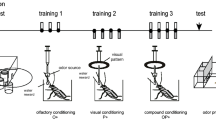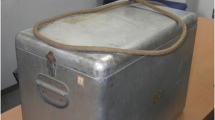Abstract
The several functions that a stimulus can assume were investigated in a Pavlovian conditioning procedure. The subjects were six rhesus monkeys; the response under observation was heart rate. The conditioning began with a temporal separation of zero between a signal and a regularly repeating electric shock; the signal was then moved to a series of earlier locations in the inter-shock interval. After six sessions at each location, two sessions followed in which only the shock was delivered periodically. The findings included: (1) A two-phased conditioned cardiac rate response seen at the first location became more multiphasic and irregular during longer intervals between signal and shock; (2) the location where the conditioned response peaked became increasingly variable as the signal was moved back, but this variability maintained a constant proportion to the signal-shock interval; and, (3) heart rate during a presignal period, and during a comparable period in shock only sessions, was generally deceleratory early in training and acceleratory thereafter. Sessions with the signal showed heart rate in the presignal period to have become acceleratory earlier in training than sessions with shock only. The data pertain to stimulus control over heart rate as a function of: (A) the temporal proximity of a signal to an aversive stimulus; and, (B) the presence or absence of the signal. The use of appropriate response units in cardiac conditioning is also discussed.
Similar content being viewed by others
References
Black, A. H.: Cardiac conditioning in curarized dogs: The relationship between heart rate and skeletal behaviour.In Prokasy, W. F. (ed.):Classical Conditioning. New York, Appleton-Century, 1965.
Black, R. W. and Black, P. E.: Heart rate conditioning as a function of interstimulus interval in rats. Psychon. Sci.,8, 219–220, 1967.
Black, A. H., Carlson, N. J. and Solomon, R. L.: Exploratory studies of the conditioning of autonomic responses in curarized dogs. Psychol. Monogr.,76, (29, Whole No. 548), 1962.
Church, R. M., LoLordo, V., Overmier, J. B., Solomon, R. L. and Turner, L.: Cardiac responses to shock in curarized dogs: Effects of shock intensity and duration, warning signal, and prior experience with shock. J. Comp. Physiol. Psychol.,62, 1–7, 1966.
Deane, G. E.: Cardiac conditioning in the albino rabbit using 3 CS-UCS intervals. Psychon. Sci.,3, 119–120, 1965.
Farmer, J. and Schoenfeld, W. N.: The effect of a response-contingent stimulus introduced into a fixed-interval schedule at varying temporal placement. Psychon. Sci.,6, 15–16, 1966. (a)
Farmer, J. and Schoenfeld, W. N.: Varying temporal placement of an added stimulus in a fixed-interval schedule. J. Exp. Anal. Behav.,9, 369–375, 1966. (b)
Fitzgerald, R. D. and Teyler, T. J.: Trace and delayed heart-rate conditioning in rats as a function of US intensity. J. Comp. Physiol. Psychol.,70, 242–253, 1970.
Fitzgerald, R. D. and Walloch, R. A.: Changes in Respiration and the form of the heart-rate CR in dogs. Psychon. Sci.,5, 425–426, 1966.
Flynn, J. P.: Discussion: Papers by W. G. Reese and W. H. Gantt. Physiol. Rev.,40 (Suppl. 4), 292–294, 1960.
Gantt, W. H.: Cardiovascular component of the conditional reflex to pain, food and other stimuli. Physiol. Rev.,40, 266–291, 1960.
Gantt, W. H., Gakenheimer, W. A. and Stunkard, A.: Development of cardiac reflex to time intervals. Fed. Proc.,10, 47–48, 1951. (Abstract)
Geer, J. H.: Measurement of the conditioned cardiac response. J. Comp. Physiol. Psychol.,57, 426–433, 1964.
Hastings, S. E. and Obrist, P. A.: Heart rate during conditioning in humans: Effect of varying the interstimulus (CS-UCS) interval. J. Exp. Psychol.,74, 431–442, 1967.
Kamin, L. J.: Temporal and intensity characteristics of the conditioned stimulus,In Prokasy, W. F. (ed.):Classical Conditioning. New York, Appleton-Century, 1965.
Katkin, E. S. and Nelson, J. S.: Habituation of cardiac components of the orienting reflex to stimuli repeated at fixed and variable intervals. Bull. Psychon. Soc.,2, 263–265, 1973.
Kelleher, R. T. and Fry, W. T.: Stimulus functions in chained fixed-interval schedules. J. Exp. Anal. Behav.,5, 167–173, 1962.
Kosupkin, J. M. and Olmsted, J. M.: Slowing of the heart as a conditioned reflex in the rabbit. Amer. J. Physiol.,139, 550–552, 1943.
Levy, M. N., Degeest, H. and Zieske, H.: Effects of respiratory center activity on the heart. Circ. Res.,18, 67–78, 1966.
Lockhart, R. A.: Comments regarding multiple response phenomena in long interstimulus interval conditioning. Psychophysiology,3, 108–114, 1966.
Moore, A. U. and Marcuse, F. L.: Salivary, cardiac and motor indices of conditioning in two sows. J. Comp. Psychol.,38, 1–16, 1945.
Moscovitch, A., and LoLordo, V. M.: Role of safety in the Pavlovian backward fear conditioning procedure. J. Comp. Physiol. Psychol.,66, 673–678, 1968.
Nathan, M. A. and Smith, O. A., Jr.: Differential conditional emotional cardiovascular responses—A training technique for monkeys. J. Exp. Anal. Behav.,11, 77–82, 1968.
Notterman, J. M., Schoenfeld, W. N. and Bersh, P. J.: Conditioned rate response in human beings during experimental anxiety. J. Comp. Physiol. Psychol.,45, 1–8, 1952.
Pavlov, I. P.:Conditioned Reflexes (Anrep, G. ed. and trans.). New York, Dover, 1960. (Originally published, 1927.)
Ramsay, D. A.: Form and characteristics of the cardiovascular conditional response in rhesus monkeys. Cond. Reflex,5, 36–51, 1970.
Ramsay, D. A., Knapp, J. Z. and Zeiss, J. C.: Transients in “constant-current” generators. Behav. Res. Meth. Instru.,2, 122–123, 1970.
Randall, D. C., Brady, J. V. and Martin, K. H.: Cardiovascular dynamics during classical appetitive and aversive conditioning in laboratory primates. Pav. J. Biol. Sci.,10, 66–75, 1975.
Randall, D. C. and Smith, O. A.: Ventricular contractility during controlled exercise and emotion in the primate. Am. J. Physiol.,226, 1051–1059, 1974.
Rescorla, R. A.: Conditioned inhibition of fear resulting from negative CS-US contingencies. J. Comp. Physiol. Psychol.,67, 504–509, 1969. (a)
Rescorla, R. A.: Pavlovian conditioned inhibition. Psychol. Bull,72, 77–94, 1969. (b)
Rescorla, R. A. and Solomon, R. L.: Two-process learning theory: Relationships between Pavlovian conditioning and instrumental learning. Psychol. Rev.,74, 151–182, 1967.
Schneiderman, N.: Response system divergencies in aversive classical conditioning.In Black, A. H. and Prokasy, W. F. (eds.):Classical Conditioning;Current Theory and Research. New York, Appleton-Century, 1972.
Schoenfeld, W, N.: The “response” in behavior theory. Pav. J. Biol. Sci.,11, 129–149, 1976.
Schoenfeld, W. N., Matos, M. A. and Snapper, A. G.: Cardiac conditioning in the white rat with food presentation as unconditional stimulus. Cond. Reflex,2, 56–67, 1967.
Segal, E. F.: Exteroceptive control of fixed-interval responding. J. Exp. Anal. Behav.,5, 49–57, 1962.
Seligman, M. E. P., Maier, S. F. and Solomon, R. L.: Unpredictable and uncontrollable aversive events.In Brush, F. R. (ed.):Aversive Conditioning and Learning. New York, Academic Press, 1971.
Skinner, B. F.:The Behavior of Organisms. New York, Appleton-Century, 1938.
Snapper, A. G. and Kadden, R. M.: Time sharing in a small computer based on a behavioral notation system.In Weiss, B. (ed.):Digital Computers in the Behavioral Laboratory. New York, Appleton-Century, 1973.
Snapper, A. G., Kadden, R. M., Shimoff, E. H. and Schoenfeld, W. N.: Stimulus intrusion on fixedinterval responding in the rat: The effects of electric shock intensity, temporal location, and response contingency. Learn. Motiv.,6, 367–384, 1975.
Snapper, A. G., Pomerleau, O. F. and Schoenfeld, W. N.: Similarity of cardiac CR forms in the rhesus monkey during several experimental procedures. Cond. Reflex,4, 212–220, 1969.
Snapper, A. G., Schoenfeld, W. N., Ferraro, D. P. and Locke, B.: Cardiac rate of the rat under a DRL and a non-contingent temporal schedule of reinforcement. Psychol. Rep.,17, 543–552, 1965.
Solomon, R. L. and Corbit, J. D.: An opponent-process theory of motivation: I. Temporal dynamics of affect. Psychol. Rev.,81, 119–145, 1974.
Washton, A. M.: Autonomic and stimulus control of cardiac responding as a function of CS-US interval. Unpublished doctoral dissertation, The City University of New York, 1978. Available from University Microfilms Cat. #78-08, 701.
Wilson, R. S.: Cardiac response: Determinants of conditioning. J. Comp. Physiol. Psychol. Monogr.,68, (l,Pt. 2), 1969.
Wood, D. M. and Obrist, P. A.: Effects of controlled and uncontrolled respiration on the conditioned heart rate response in humans. J. Exp. Psychol.,68, 221–229, 1964.
Zeaman, D. and Smith, R. W.: Review and analysis of some recent findings in human cardiac conditioning.In Prokasy W. F. (ed.):Classical Conditioning: A Symposium. New York, Appleton-Century, 1965.
Author information
Authors and Affiliations
Additional information
The study was supported by the Medical Research Service of the Veteran’s Administration, and by the National Institute of Mental Health Grant # MH-13049.
Rights and permissions
About this article
Cite this article
Turkkan, J.S. Varying temporal location of a conditioned stimulus in heart rate conditioning ofMacaca mulatta . Pav. J. Biol. Sci. 14, 31–43 (1979). https://doi.org/10.1007/BF03001814
Issue Date:
DOI: https://doi.org/10.1007/BF03001814




